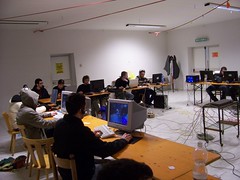![[diggwarlick.jpg]](http://bp3.blogger.com/_gBNdC5daKNI/RqU2sSs_rhI/AAAAAAAAAHA/rAvVsxg0cJQ/s1600/diggwarlick.jpg) |
| A screen shot that Scott took during the presentation. The window to the left, with the arrow, is the slide show — via SlideShare. |
It’s not every day that I get to do a presentation and stay home at the same time. Scott Merrick contacted me a couple of weeks ago, describing a workshop he was planning for teachers in the Nashville area. He asked if I would be available to Skype in to the workshop and talk a bit about Web 2.0 and its implications for literacy. We tested our Skype connection in the morning, with no glitches, and then scheduled my presentation for 2:00 (east coast time).
Of course, there were some glitches at 2:00, as I was not able to see my audience, via Scott’s camera, but my iSight worked well, and I’m getting better at presenting into a camera. Use to terrify me — completely befuddle my mind.
I re-worked one of my presentations, and uploaded it to SlideShare. I then added a link to the online handouts blog posting for the session, that clicked out a small browser window, sized for the slides, so that each participant was able to follow along with the slides.
I also set up the Twitteresque chat page for the group, and this is what was interesting. They participated in the chat, posing questions, making comments, saying, “Hi!” more than any group so far — and I wonder why that was. Was it because I wasn’t there? Was it that they didn’t feel the need of courtesy to keep eye contact with me? Was it that they were all sitting with desktop computers in front of them? Was it that they had command of the slide show? I am curious!
After the presentation, I transferred the chat transcript over to a wiki for the group, and inserted a few comments of my own, responding to some of their questions. All-in-all, it was an interesting experience that I am getting more accustomed to. It isn’t like being there. Nothing’s like being there. But virtual presentations are working. Who would have thought?

 Brenda and I just got back from the Raleigh Farmer’s Market. I was surprised at how busy they were. We actually had to leave some stalls and come back later because of the demand — mostly for peaches. Most stalls were a repeat of tomatoes, field peas, young potatoes, okra, and just about every variety of squash and eggplant imaginable.
Brenda and I just got back from the Raleigh Farmer’s Market. I was surprised at how busy they were. We actually had to leave some stalls and come back later because of the demand — mostly for peaches. Most stalls were a repeat of tomatoes, field peas, young potatoes, okra, and just about every variety of squash and eggplant imaginable. The book,
The book,  My sessions are over, and the ferry is waiting. But there is one final session, a panel discussion of some teenagers — the Net Generation. I middle schooler, one graduating senion, on rising senior, and an elementary school. The graduated senior just said that schools should be the first place where new technologies appear. They attended a session here about podcasting and were, evidently, impressed. They want to see podcasting in their classrooms.
My sessions are over, and the ferry is waiting. But there is one final session, a panel discussion of some teenagers — the Net Generation. I middle schooler, one graduating senion, on rising senior, and an elementary school. The graduated senior just said that schools should be the first place where new technologies appear. They attended a session here about podcasting and were, evidently, impressed. They want to see podcasting in their classrooms. Up early. With no keynote to do today and with the video games session already part of my muscle memory, I’m reviewing some of my notes from the
Up early. With no keynote to do today and with the video games session already part of my muscle memory, I’m reviewing some of my notes from the 
 Pink is describing how he was an extremely, unextraordinary student. His position in law school made the upper 90% possible. He went to law school because it was believed that you would be fine. It made sense in the 20th century. Those skills still matter, but they do not matter as much now.
Pink is describing how he was an extremely, unextraordinary student. His position in law school made the upper 90% possible. He went to law school because it was believed that you would be fine. It made sense in the 20th century. Those skills still matter, but they do not matter as much now. So with abundance, there is competition. I want you to buy my stuff. But I don’t want to lower prices. It’s a death spiral. Instead, I want to concentrate on asthetics — layoff the engineers and hire designers.
So with abundance, there is competition. I want you to buy my stuff. But I don’t want to lower prices. It’s a death spiral. Instead, I want to concentrate on asthetics — layoff the engineers and hire designers.
 Unique & Compelling Internet Applications for the 21st Century Learner — from
Unique & Compelling Internet Applications for the 21st Century Learner — from  I’ve continued to be intrigued by Twitter, the web app that asks, “Why do I keep using this?” Well the answer is that tucked in between rants about the Cubs, crying babies, solitary bicycle rides, and proclamations of insomnia, are nuggets of knowledge and pathways to learning.
I’ve continued to be intrigued by Twitter, the web app that asks, “Why do I keep using this?” Well the answer is that tucked in between rants about the Cubs, crying babies, solitary bicycle rides, and proclamations of insomnia, are nuggets of knowledge and pathways to learning.